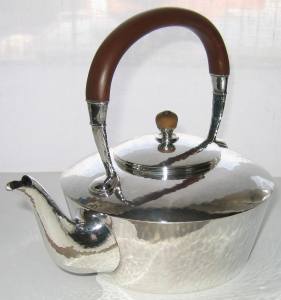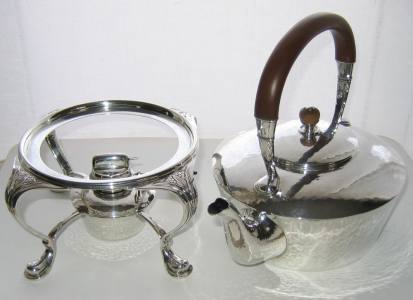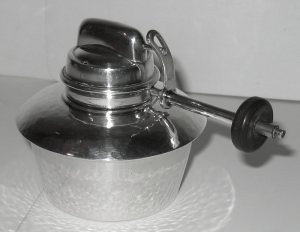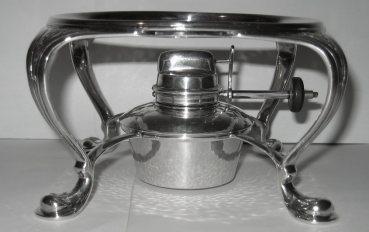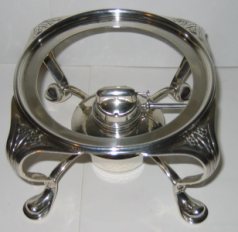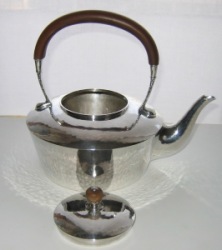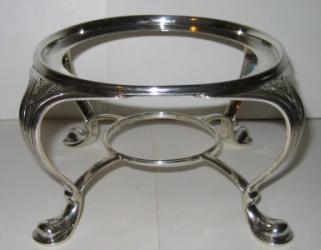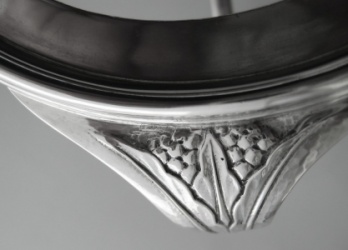|
(click on images to enlarge)
A TEA KETTLE BY LIBERTY & COMPANY
From the second quarter of 1900 while in
Scandinavia was becoming popular the simple,
attractive and functional style introduced by Georg
Jensen, in other parts of Europe, including the
United Kingdom, the few silversmiths who left the
conservatism of their productions, were more aimed
at pure lines and geometric forms, not always of
functional use, dictated by the Modernism continuing
in a non-positive way the path opened by Christopher
Dresser.
A pleasant exception in U.K. is represented by the
production of Liberty and Co. and the beautiful
designs of C. R. Ashbee in "Arts & Crafts" style.
Large manufacturers such as Mappin & Webb, Walker &
Hall, Elkington, William Hutton & Sons, Arthur Price
& Co were instead mostly concerned to the merely
commercial production of silverware and only
occasionally engaged talented designers as was Keith
Murray by Mappin & Webb.
Kettles have been introduced in Queen Anne period
(beginning of 1700) and their evolution in style has
closely followed that of contemporary teapots, at
least in the XVIII century. Contrary to Samovar,
introduced in George III period (in the third
quarter of 1700) and used exclusively as storage
tanks for water for making tea (especially for
social events), kettles were used mainly by private
people and were intended for the preparation of tea,
rather than as hot water only. For this reason the
spout for pouring tea is internally protected by a
perforated grid that can hold the tea leaves after
infusion.
|
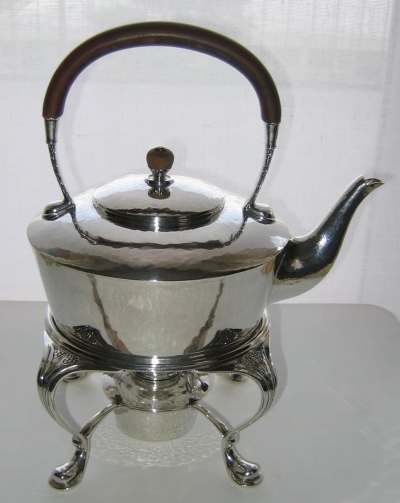
|
This tea kettle was manufactured by Liberty & Co and
hallmarked in Birmingham in 1924.
Liberty & Co. is the company founded by Arthur Lasenby Liberty (see ENDNOTE),
which produced artifacts in a unique and original style, opposed
to the prevailing Aesthetic Movement and Art Nouveau design.
The maker mark of Liberty & Company (L & Co in a three lozenges
punch) is struck on each piece, including the removable cover,
as well as the lion passant (for sterling silver), the anchor
(for the Birmingham Assay office) and the date letter "z" in a
lowercase (for 1924).
The burner is not marked and it is therefore likely to have
been made of silver plated metal.
Special characteristics of the production of Liberty &
Company are the taper shape tending to cylindrical of the pot
and the burner, the decoration of the corner of the stand and
the surface worked by hammer, already found in "Arts & Crafts"
artifacts, but played by Liberty & Co. in a more nuanced and
less provocative way, that was not obtained by working directly
on the piece, but usually obtained by working by hammer the
molds.
The condition of this kettle is excellent, with only the lack of
one wheel of wood of the burner which function was to facilitate
the extraction of the wick.
Dimension:
Kettle: 23,5 cm wide; 13,7 cm max cross section; 19 cm tall
Stand: 15 cm wide; 9,5 cm tall
Burner: 7 cm wide; 7 cm tall
total height: 28 cm
Weight:
Kettle: 764 grams; Stand 565 grams Burner: 112 grams - combined
weight: 1441 g
ENDNOTE
More in "Arthur Lasenby Liberty and the Evolution of the Liberty Style" at http://www.victorianweb.org/art/design/liberty/lstyle.html
|


